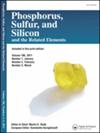Efficient bis(indoyl)methanes synthesis enabled by SnO2/SiO2 nanocomposite
IF 1.4
4区 化学
Q4 CHEMISTRY, INORGANIC & NUCLEAR
Phosphorus, Sulfur, and Silicon and the Related Elements
Pub Date : 2024-09-02
DOI:10.1080/10426507.2024.2410869
引用次数: 0
Abstract
This study focuses on the synthesis of SnO2/SiO2 nanocomposite materials using sol-gel method and investigates their role in the synthesis of bis(indoyl)methanes via the Friedel–Craft alkylation route. The results, based on TON and TOF, show that 15 wt % SnO2/SiO2 exhibits high production efficiency and greater stability, with yields reaching 91–93% within 80–93 min. The prepared catalysts were characterized using various analytical techniques. The XRD revealed a crystalline size of 25.05 nm. The TEM analysis indicated a reduced particle size of about 25–30 nm. The SEM reflected the porous nature of the material and EDS showed the constituent elements Sn, O and Si with 3.65, 54.93, and 41.44 atomic %, respectively. FT-IR identified the composite framework with bands at 3408, 1620, 1093, 806 and 631 cm−1. The NH3-TPD indicated the presence of both Lewis acidic and Bronsted acidic sites in the composite materials. The BET method revealed a specific surface area and average pore diameter of 331.5814 m2/g. The developed method offers several advantages, such as a simple workup procedure, high yield, nontoxicity, cleanliness, and the ability to recycle and reuse the catalytic materials three times without loss in catalytic activity. These findings demonstrate the potential of SnO2/SiO2 nanocomposites as efficient and environmentally friendly catalysts for the synthesizing bis(indoyl)methane derivatives.
求助全文
约1分钟内获得全文
求助全文
来源期刊
CiteScore
2.60
自引率
7.70%
发文量
103
审稿时长
2.1 months
期刊介绍:
Phosphorus, Sulfur, and Silicon and the Related Elements is a monthly publication intended to disseminate current trends and novel methods to those working in the broad and interdisciplinary field of heteroatom chemistry.

 求助内容:
求助内容: 应助结果提醒方式:
应助结果提醒方式:


